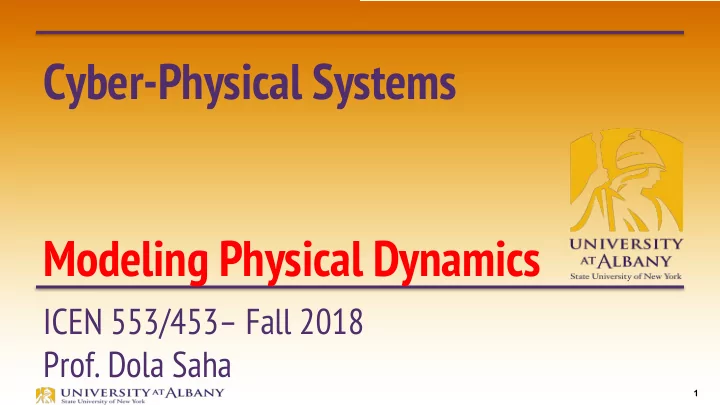

Cyber-Physical Systems Modeling Physical Dynamics ICEN 553/453– Fall 2018 Prof. Dola Saha 1
Modeling Techniques Ø Models that are abstractions of system dynamics (how system behavior changes over time) § Modeling physical phenomena – differential equations § Feedback control systems – time-domain modeling § Modeling modal behavior – FSMs, hybrid automata, … § Modeling sensors and actuators –calibration, noise, … § Hardware and software – concurrency, timing, power, … § Networks – latencies, error rates, packet losses, … 2
Modeling of Continuous Dynamics Ø Ordinary differential equations, Laplace transforms, feedback control models, … 3
Example CPS System: Helicopter Dynamics 4
Modeling Physical Motion Ø Six Degrees of Freedom § Position: x, y, z § Orientation: pitch, yaw, roll 5
Notation Chapter 4 in https://www.math.ucdavis.edu/~linear/linear-guest.pdf 6
Notation 7
Newton’s Second Law 8
Orientation 9
Torque: Angular version of Force T y (t ) = r f (t ) Just as force is a push or a pull, a torque is a twist. angular momentum, momentum Units: newton-meters/radian, Joules/radian 10
Rotational Version of Newton’s Law http://farside.ph.utexas.edu/teaching/336k/Newtonhtml/node64.html 11
Feedback Control Problem A helicopter without a tail rotor, like the one below, will spin uncontrollably due to the torque induced by friction in the rotor shaft. Control system problem: Apply torque using the tail rotor to counterbalance the torque of the top rotor. 12
Simplified Model 13
Actor Model Ø Mathematical Model of Concurrent Computation Ø Actor is an unit of computation Ø Actors can § Create more actors § Send messages to other actors § Designate what to do with the next message Ø Multiple actors may execute at the same time 14
Actor Model of Systems Ø A system is a function that accepts an input signal and yields an output signal. Ø The domain and range of the system function are sets of signals, which themselves are functions. Ø Parameters may affect the definition of the function S . 15
Actor Model of the Helicopter Ø Input is the net torque of the tail rotor and the top rotor. Output is the angular velocity around the y- axis. Ø Parameters of the model are shown in the box. The input and output relation is given by the equation to the right. 16
Composition of Actor Model 17
Actor Models with Multiple Inputs 18
Modern Actor Based Platforms Ø SPW, signal processing worksystem Ø Simulink (The MathWorks) (Cadence) Ø Labview (National Instruments) Ø System studio (Synopsys) Ø Modelica (Linkoping) Ø ROOM, real-time object-oriented Ø OPNET (Opnet Technologies) modeling (Rational) Ø Polis & Metropolis (UC Berkeley) Ø Easy5 (Boeing) Ø Gabriel, Ptolemy, and Ptolemy II (UC Ø Port-based objects (U of Maryland) Berkeley) Ø I/O automata (MIT) Ø OCP, open control platform (Boeing) Ø VHDL, Verilog, SystemC (Various) Ø GME, actor-oriented meta-modeling (Vanderbilt) 19
Example LabVIEW Screenshot 20
Recommend
More recommend